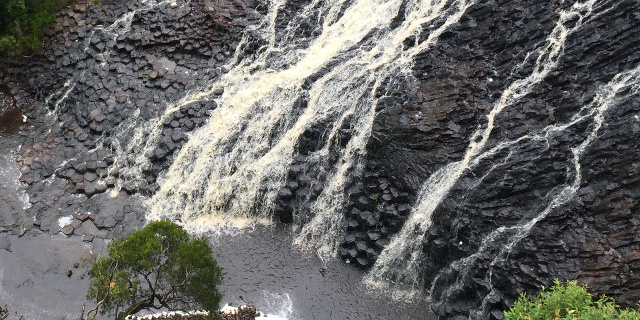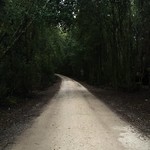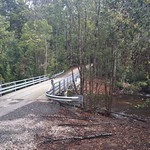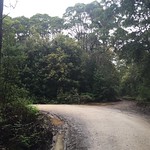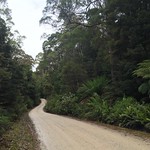Dip Falls are found in the Dip River Forest Reserve, near Mawbanna in the northwest of Tasmania, Australia. They flow across two layers of black basalt columns, which give the falls a unique appearance among the hundreds of Tasmanian waterfalls.
Update
Parks & Wildlife upgraded the steps to Dip Falls in July 2017. The report below no longer describes the track accurately.
Four short walks lead to the base of the falls, a viewing platform, an old sawmill boiler and the “Big Tree”. While the base of the falls involves a long flight of steps, the other three walks would admit wheelchairs with some effort.
The “Big Tree” in the Dip River Forest Reserve should not be confused with the “Big Tree” and “Bigger Tree” in the Styx Big Tree Reserve in Tasmania’s south.
Getting there
The route to Dip Falls began with turning off the Bass Highway onto Mawbanna Road, south and east of Stanley. The Mawbanna Road wound around farms and hills; it was sealed but not fast or easy to drive, especially when a loose cow wandered onto the road.
After about 24 kilometres, Mawbanna Road reached a right turn onto Dip Falls Road. This was unsealed, but wide and in good condition, and only two kilometres remained to Dip Falls. The Big Tree was another kilometre further on.
Dip Falls Base
The route to the base of the falls was down a long and steep flight of stairs. This took little time but a lot of effort. It led to a lower near-vertical fall which was not visible from anywhere else.
Dip Falls Viewing Platform
The viewing platform was accessible from a short level track. It had a good view over the upper fall and down the valley to the west.
Sawmill boiler
During the early 20th century there were three houses and a sawmill on the Dip River. The forest had reclaimed most of the ground, but a rusting boiler from the sawmill was still visible along one of the tracks.
The Big Tree
The Big Tree was a brown top stringy bark (Eucalyptus obliqua). A sign explained that:
The tree is 62 metres tall. This is not exceptional, given that this species typically attains heights between 45 and 90 metres. The tallest trees are found in wet eucalypt forest where the rainforest is high and the soils are fertile. In Tasmania, the tallest Browntop stringybarks grow in the Florentine Valley, near Maydena.
The exceptional fact about this tree is its circumference. It’s 16 metres around the base, which is unusually large. See how many people it takes to join a circle around the tree.
Plants
Ferns flourished along the Dip River, especially treeferns. A few plants flowered among the moss.
Fungi
The Dip River Forest Reserve was particularly rich in bracket fungi. Ferns – especially treeferns – were also common, even when compared to other rainforest areas in Tasmania.
Animals
Animals were no doubt present, but not easy to find. A Sugden’s flatworm (Fletchamia sugdeni) was easy to spot near the base of the falls. Spiders’ webs were common even if the spiders were absent. Occasional birds flew past the viewing platform.
Video
Facilities
| Latest visit | 24th November 2014 |
|---|---|
| Road | Unsealed for two kilometres |
| Parking | Medium |
| Shelter | Yes |
| Toilets | Yes (flushing!) |
Opinions
Walking Stick
This was great spot for those who need flat ground. The toilet had wheelchair access, and the picnic shelters were wheel friendly. The walks to the wonderful viewing platform, the Big Tree and the boiler were unsealed but wide and sound with a chance to really get into the bush in comfort.
The steps to the base of the falls had a handrail but were steep and uneven. They were only for the able or foolhardy – but there was plenty to enjoy here without venturing to the bottom of the falls.
Ambler
Walked 2 kilometres in 2:07. Visited the falls base, boiler and viewing platform, then walked along the road to the Big Tree.
Considered all parts to be worthwhile, including the walk along the road with dense rainforest on both sides. The falls base with its basalt columns was a highlight.
Racewalker
This was a fascinating waterfall. Although the brisk walk to and from the Big Tree was good and walking the two kilometres back to the sealed road would have been pleasant, it was worth visiting the lookout twice and spending time just admiring the rocks, rather than just dashing in and out as usual.
Should I visit?
Yes. This is a really nice part of Tasmania’s rainforest. It is accessible to almost everyone. It is also worth a look even if you have taken many other, longer walks. You can see most of it in 20 minutes, or spend two hours admiring every detail.
For travellers not living on Tasmania’s north-west coast, Dip Falls alone would probably not justify the 3+ hours of driving each way needed to get there. Plan at least one other activity for your day (such as The Nut at Stanley or Rocky Cape National Park). Even better, stay for a few days in the north-west – there is plenty to justify your visit.
Visit in a wet season to see the flow at its widest, or in a dry season to admire the geology.
References
Parks & Wildlife Service Tasmania – Improved access to two of the North-west’s natural wonders
Waterfalls of Tasmania – Dip Falls
Roaming Down Under – Dip Falls
StepScape – Dip Falls car park
